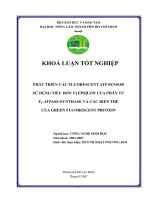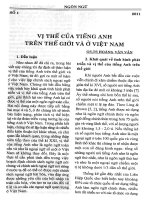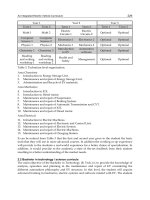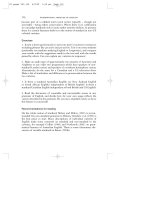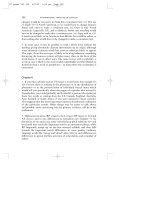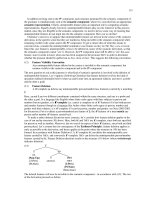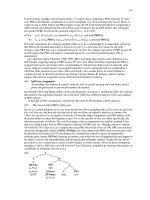Các biến thể của tiếng anh part 13 pot
Bạn đang xem bản rút gọn của tài liệu. Xem và tải ngay bản đầy đủ của tài liệu tại đây (140.65 KB, 10 trang )
become part of a codified norm (such norms typically – though not
inevitably – being rather conservative). Where there is no codification
we can judge standards only in some rather intuitive fashion. At present,
there is a certain fuzziness built in to the notion of standard in non-US
colonial varieties.
Exercises
1. Invent a short questionnaire to test your peers’ reactions to sentences
including phrases like you and I and you and me. Test it on some students
(preferably not students studying English or Linguistics), and compare
your results with the suggestions made in the text and with the results
gained by others. Can you explain any variation in responses?
2. Make an audio tape of approximately ten minutes of Eastenders and
Neighbours or any other two programmes which have speakers of non-
standard London variety and speakers of a southern hemisphere variety.
Alternatively, do the same for a Canadian and a US television show.
Make a list of similarities and differences in pronunciation between the
two varieties.
3. Is there a standard Australian English (or New Zealand English
or South African English) independent of British English? Is there a
standard Canadian English independent of both British and US English?
4. Read the discussion of countable and uncountable nouns in any
grammar of English, and decide how far your own usage reflects the
variety described in the grammar. Do you use a standard variety as far as
this feature is concerned?
Recommendations for reading
On the whole notion of standard, Milroy and Milroy (1985) is recom-
mended. On non-standard grammar in Britain, Cheshire et al. (1989) is
the best place to start. Many descriptions of individual varieties of
English make some comment on standard and non-standard in the
colonies, for example Collins (1989) and Newbrook (2001) on gram-
matical features of Australian English. There is some elementary dis-
cussion of variable standards in Bauer (1994b).
112 INTERNATIONAL VARIETIES OF ENGLISH
02 pages 001-136 6/8/02 1:26 pm Page 112
Discussion of the exercises
Chapter 1
1. The point of the question is that you cannot simply guess, you have
to investigate sources of historical information – histories of English,
historical dictionaries and the like. In the particular cases chosen in the
question the facts are as follows:
a) Canadian raising: It is often commented that Canadian raising is not
Canadian and may not be raising. A similar phenomenon is found in
much of the northern USA and in a small area in the fens in England.
Nevertheless, the Canadian phenomenon is probably independent of
the English one, and comments about it are found from the late 1930s
onwards. It thus seems that this is a very recent phenomenon (Chambers
1989) and not colonial lag.
b) Did you eat yet? : This is a question on which it is difficult to get good
data. The most significant-looking piece of data I have found is that
Strevens (1972) fails to mention this syntactic difference between British
and American varieties of English, while Quirk et al. (1985: 194) do draw
attention to this American preference. If this reflects genuine difference,
it suggests that it is a recent development in American English, and
not colonial lag. Better evidence might arise from finding the two con-
structions in novels, films, plays, etc. written earlier in the twentieth
century, or from finding discussions of these constructions in English
language teaching texts from both sides of the Atlantic.
c) Biscuit : The OED is of remarkably little help in dating the advent of
sweet biscuits, providing only one citation (dated 1870) for the modern
British usage where biscuit is used mainly for a sweet biscuit. Still it
is clear that biscuits were not always sweet in Britain (think of ship’s
biscuits, for example), which implies that British usage has changed. The
US usage preserves an older sense. This is colonial lag.
113
02 pages 001-136 6/8/02 1:26 pm Page 113
2. You should be able to hear some differences, but if you cannot, you
should think about why that might be. For instance, does one of the
speakers use a variety which you perceive as being lower class or other-
wise unworthy of imitation? Do you dislike one of the people? Have you
never spoken to anyone with that particular accent before? Are you fail-
ing to hear differences which are actually present? The features that you
change ought to be features you are not only aware of, but which you feel
typify the accent of your interlocutor. Pronouncing /
r/ in words like car
and cart is far more usual for a non-rhotic speaker talking to a speaker of
standard US English than, say, pronouncing cot and caught with the same
vowel. Note that the pronunciation of /
r/ is also supported by the
spelling.
3. The initial <
v> in fog and <z> in sober, and the vowels in go and mother
represent matters which are entirely to do with pronunciation, and thus
accent.
The plural form of eye, the use of the second person singular, the use of
thee in subject position, the use of as to introduce a relative clause, the use
of the adjectival form sober rather than adverbial soberly and the use of
Never God made in place of the modern Never did God make (or God never
made) are all dialect forms, being matters of grammar. There are no
instances of dialect vocabulary in this passage (unless sober is taken to be
one). A few lines further on, though, Blackmore introduces the word
goyal, defined as ‘a long trough among wild hills, falling towards the plain
country’, which is also a matter of dialect.
4. In the English cases, rhoticity is less prestigious than non-rhoticity,
just the converse of the New York situation. Yet the reasons are the same
in both places: the national standard pronunciation is the one which
offers the prestige. However, if the same feature can have high prestige
in one place and low prestige in another, it implies that what is con-
sidered ‘good’ English is not a matter of the linguistic form itself, but a
matter of social judgement. Rhoticity as a phenomenon is neither good
nor bad.
Chapter 2
1. There are a number of points that could be made about Figure 2.4.
The most obvious one is that the outside circle in the figure lists varieties
of different kinds. There are purely regional varieties (and these are the
only varieties listed in South Asia and Africa), but also social varieties
114 INTERNATIONAL VARIETIES OF ENGLISH
02 pages 001-136 6/8/02 1:26 pm Page 114
(such as BBC English), varieties which are not really independent (such
as franglais), and contact varieties (such as Tok Pisin), alongside native-
speaker varieties. In effect, at least four circles are needed, with social
varieties providing a circle outside the regional varieties. The result is
that the sectors on the diagram are not all exactly equivalent. You may
also have found other points worthy of comment.
2. First we need to realise that [
υ] is perceived as being a northern
variant of [
] in England, so that the two are, on some level, equivalent
pronunciations: cup is pronounced with [
] in the south, but with [υ] in
the north, even though both use [
υ] in words like push. Then we need to
note that the English pronunciation with [
] or [υ] is largely from the
eastern counties, while the western counties have the standard [
] vowel
in this position. Since the Massachusetts area of the USA was settled
from the eastern counties of England, it is not surprising that [
] should
have been the most widespread variant there, and adopted as a norm,
while settlers further south would have come from western counties,
where [
] was (and remains) the norm. You can see on the North
American map that attestations of [
] fade out as you move south and
west, away from the area of original eastern counties settlement.
3. The alternative would be that New Zealand English is a direct
descendant of English English, parallel to Australian English (and also
South African English which is not shown in Figure 2.2).
For the most part, similar predictions would follow from either
hypothesis:
• The grammar of the two varieties should be very similar, either
because New Zealand English has not yet had much time to diverge
from Australian English or because the two derive from basically the
same English English grammar.
• The vocabulary should be similar except where loans from Maori in
New Zealand and Aboriginal languages in Australia are concerned.
This is either because New Zealand English vocabulary is fundamen-
tally the same as Australian English vocabulary, with just some very
recent differences, or because both derive from the same range of
British vocabulary.
• Pronunciation should be fairly similar. This is either because New
Zealand English pronunciation is Australian English pronunciation
which has had a relatively short time to diverge from its parent, or
because both New Zealand and Australian English pronunciations
derive from mixtures of similar speakers at approximately the same
DISCUSSION OF THE EXERCISES 115
02 pages 001-136 6/8/02 1:26 pm Page 115
time – and because New Zealand English is in any case influenced by
Australian English as its closest neighbour.
The differences are more difficult to be precise about:
• Since the mixture of people who settled in Australia was not the same
as the mixture of people who settled in New Zealand (for example
there were no penal colonies in New Zealand; the first settlers in New
Zealand tended to come from rural not urban backgrounds) there
should be some observable results of the different mixtures if we have
two parallel developments. Unfortunately, it is virtually impossible to
say what those differences should be because we do not have enough
detailed information, and thus it is impossible to judge whether the
observed differences between Australian and New Zealand Englishes
could be caused by the different population mixes.
• There is some Australian English vocabulary which is not widely used
in Britain but which is nevertheless found in New Zealand. It is
argued in Bauer (1994a) that this is sufficient to make a case for New
Zealand English being derived from Australian English, but the point
is controversial and the relevant words could be later loans from
Australian English into New Zealand English.
Chapter 3
1.
Word Place used Meaning
bayou USA marshy part of a river
caribou Canada kind of reindeer
dingo Australia wild dog
Eskimo Canada the aboriginal people of northern
Canada, Alaska, Greenland (now usually
Inuit); their language (now usually
Inuktitut)
hickory USA tree with tough wood bearing edible
nuts
kangaroo Australia any member of the family of marsupials
having long feet, short forelimbs, a long
tail for balance
kauri New Zealand tree with hard wood
kookaburra Australia large kingfisher
116 INTERNATIONAL VARIETIES OF ENGLISH
02 pages 001-136 6/8/02 1:26 pm Page 116
Word Place used Meaning
masonja South Africa mopani worm
minnerichi Australia tree with curling bright red bark; the
tough wood from the tree
mobola South Africa plum-like fruit; the tree on which it
grows
moose Canada type of large deer; elk
mulla mulla Australia pussy tail; a shrub with a large, fluffy
flower head
pichou Canada lynx
quagga South Africa various types of zebra
raccoon USA, Canada small nocturnal carnivore, with mask-
like markings on the face
sassafras USA small tree with aromatic leaves and bark
skunk USA, Canada cat-sized carnivore, related to weasels,
known for its black and white markings
and its powerful stink
squash USA, Canada kind of pumpkin eaten as a vegetable
toboggan Canada sledge
toetoe New Zealand pampas grass
tsamma South Africa a trailing plant of the Kalahari; the
melon that grows on it
tsetse South Africa a biting fly which transmits sleeping
sickness
tuatara New Zealand lizard-like reptile
tui New Zealand song bird
2. You may find sets like the following:
aubergine eggplant
bap bread roll bun roll
batter cake drop scone pancake pikelet
biscuit cookie
candy lolly spice sweet
chips french fries
chips chippies crisps
courgette zucchini
dark chocolate plain chocolate
French beans string beans
DISCUSSION OF THE EXERCISES 117
02 pages 001-136 6/8/02 1:26 pm Page 117
ground meat hamburger mince
jam jelly
jello jelly
lemon cheese lemon curd lemon honey
liquor spirits
porterhouse sirloin
mineral (water) pop soda soft drink
Sometimes, these are not easily distinguished by area. For example,
courgette and zucchini are both found in New Zealand, usually with no
meaning difference, though some people distinguish in terms of size.
Cookie is used in many areas outside North America, but in those areas
means a special kind of biscuit; in North America a cookie is not a kind
of biscuit. You may also have listed words which are differentiated by
being dialectal variants within one country (for instance, spanish is used
in parts of Britain for ‘liquorice’). What is the difference, if any, between
variation between nations and dialectal variation within one nation?
3. The passage is taken from Terry Pratchett’s The Last Continent (New
York: HarperTorch, 1999: 57–8). This is a fantasy novel, set in the
Discworld version of a continent very like Australia. The resonances of
Australian English (boomerang, mate, tucker, beaut) are thus entirely delib-
erate. Yet the passage is written by an Englishman, and could thus be
said to be written in the English of England. Alternatively, it might be
claimed that this is actually a representation of the English (or other
language?) of the Discworld. The point may appear trivial, but is not. We
recognise various items in this particular text as being Australian, yet to
the extent that it is written in Australian English at all, it is written in a
copy of Australian English. On the one hand this relates to the nature of
pretence (when film stars play roles where they adopt an accent which is
not their own, do they really speak the variety of English which their
characters are supposed to be speaking?), on the other it relates to the
nature of something like ‘Australian English’: does Australian English
exist except in the actions of Australians? Is Australian English purely
a matter of vocabulary choice? Can we really distinguish Australian
English from English used to discuss Australia?
4. There are too many options here to tell what you are likely to have
found, but consider the pair pants/trousers. Trousers is still not much used
in the USA and Canada, but elsewhere pants has been encroaching on the
territory of trousers for over fifty years. However, there is no simple
replacement of one by the other. Pants has come in stealthily through
118 INTERNATIONAL VARIETIES OF ENGLISH
02 pages 001-136 6/8/02 1:26 pm Page 118
fixed phrases such as toreador pants, ski pants, pant(s) suit, and is probably
still used more for women’s garments than for men’s. The development
is only imperfectly reflected in the various editions of The Concise Oxford
Dictionary. In the fifth edition (1964) pants is defined as ‘(Chiefly US)
trousers; … (shop) long tight drawers’. In the sixth edition (1976) that is
amended to ‘trousers or slacks; … underpants’ with further reference to
pants suit and bore/scare the pants off and with one’s pants down. And in the
eighth edition (1990), the development is apparently reversed, so that it
reads ‘Brit underpants or knickers. … US trousers or slacks’ with the
same further examples.
5. There are similarities in the sense that the words listed refer to facets
of Jewish culture for which there are not standard English words (a
Jewish funeral is clearly perceived as being different in kind from a non-
Jewish funeral). What is missing (and this is a major difference from the
colonial situation) is words for flora and fauna. The reason is obvious:
there were no flora and fauna in North America at the time of arrival
of the Jewish settlers for which they had a name and the local north
Americans did not. You can try the same exercise with borrowings from
any language into English: either think up your own examples, or search
the etymology section of The Oxford English Dictionary, or find some
word-lists from any good history of the English language.
Chapter 4
1. The main point which should emerge from this exercise is how
rare most of the relevant constructions are, and thus how much text you
have to read through to find examples. This is, of course, relevant in
explaining why the variation should occur where it does. How would
you explain the correlation? In deciding whether the variation is in the
expected direction, you need to be very careful with variation where
Variety A allows variants x and y but Variety B allows only y: if y occurs
in your texts for both A and B you may be surprised at the result, even
though it is one of the predicted outcomes. Trudgill and Hannah (1994)
are particularly good at drawing attention to such cases.
2. The alternatives that are presented below are not necessarily exhaus-
tive, and the national markings given are suggestive rather than defi-
nitive, suggested by observation, by handbooks such as Trudgill and
Hannah (1984), Todd and Hancock (1986), Benson et al. (1986: 21–3)
and by dictionaries. Frequently such sources are limited to differences
between British and American usage, and it may not be clear how these
DISCUSSION OF THE EXERCISES 119
02 pages 001-136 6/8/02 1:26 pm Page 119
generalise to other varieties. Lack of marking acknowledges the vari-
ation without attributing it to differences between national standards. I
have added comments where necessary. The symbol ‘Ø’ means ‘zero’,
that is, all prepositions may be omitted.
a) in at
b) Ø on (my children used this at school in New Zealand, but it is
not general in adult language)
c) Ø (UK) from (US)
d) Ø (UK) from (US)
e) out (US) out of (UK)
f) in (UK) on (US)
g) in (US) for (UK)
h) off (UK) off of (US)
i) to (UK) toward(s) (UK) (it is not clear whether the same variation is
found outside the UK)
j) at in
k) in/on under (Aus, NZ)
l) with to
m) of Ø (this option is mainly restricted to oral usage, but is now
spreading into written usage, particularly in the USA)
3. The question assumes that there is a clear colonial variant and a clear
Home variant; this may not always be true. In any case, in many instances
the answer will be unclear: Did you eat yet? seems simpler than Have you
eaten yet? only in not requiring a past participle form eaten – no great gain.
It might seem less simple in over-riding the ‘present relevance’ effect
which the perfect is usually required for. Be in (the) hospital seems no
simpler one way or the other. Did you used to is probably simpler than
Used you to (despite being marginally longer) in that it makes used more
consistently like a main verb (it takes to like a main verb already).
4. If you suggest using texts, you run into problems (a) and (b). If you
suggest asking speakers directly, you run into problem (c). Perhaps the
best option would be to present speakers with some very restricted
scenarios, and ask them to write down their responses or tick one
preferred option from a short list of possible responses. For instance:
‘You go to the fish shop and look round, but you cannot see any cod,
although that shop is famous for its fresh cod. You ask the fishmonger:
“…”’ (with either a blank left, as here, or a series of options such as
‘(a) Have you any fresh cod?, (b) Do you have any fresh cod?’ and so on.
Interviews and writing are both likely to produce fairly formal language,
which deals with (c) to some extent; writing a tight scenario can go some
120 INTERNATIONAL VARIETIES OF ENGLISH
02 pages 001-136 6/8/02 1:26 pm Page 120
way to dealing with (b); and using a questionnaire deals with (a). You can
probably think of other problems with this method, though. You might
like to try it with a small number of questions and just a few interviewees
to see whether it would work or not.
Chapter 5
1. Tire Centre must be a Canadian spelling, because only in Canada do
we find the North American variant <tire> alongside the final <re> in
words like centre.
2. The passage is taken from The Sydney Morning Herald of 9 August
1999, p. 14. The ellipses are to avoid wordings which give away the
Australian context without reference to the spelling. However, the
spelling is sufficient to make clear that this is an Australian text. First
the use of <ise> in subsidised and the use of <re> in theatre guarantee that
the text is not North American in origin. The initial <i> in inquiry is,
these days, not significant as to origin. While British texts still prefer the
<e> spelling, both are used there, and the <e> spelling is not used in
the US. Finally, we have Labor, which, while it could be North American
on its own, cannot be when it co-occurs with the other markers, and so
shows the text to be Australian.
3. Some parts of the task would be easy, in particular the lexical differ-
ences such as grey/gray which are fairly well maintained. It would prob-
ably be impossible to do the job completely, though, since there is so
much variation on both sides. Given <ize> in an American text, it is not
absolutely certain that it should be made British by changing it to <ise>
– not only because of words like supervise, but because there is free
choice in British English between the two in words like naturalise. Since
British spellers can write biased as well as biassed, and American spellers
can vary between kidnaping and kidnapping, there is no simple way to get
from ‘the’ British version to ‘the’ American version or vice versa, unless
you are willing to be extremely prescriptive about what is permitted in
the output.
4. I like to fantasise (i) that someone does me the sizeable (ii) honour (iii) of
providing me with a travelling (iv) scholarship to visit the Centre (v) for Gypsy
(vi) Studies. (i) <ize> is acceptable everywhere, so no other changes
would be needed. (ii) A version with no <e> after the <z> is acceptable
everywhere, so no other changes would be needed. (iii) The <or>
spelling is possible in Australia as well as in North America, so no other
DISCUSSION OF THE EXERCISES 121
02 pages 001-136 6/8/02 1:26 pm Page 121
